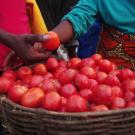This fact sheet describes and depicts the stages of maturity for pineapples, as well as information on quality and common defects This document was created as part of the Horticulture Innovation Lab project focused on reducing postharvest loss in Rwanda.
Maturity indices
There are five stages of maturity for pineapples. Harvest occurs during the third stage. The size, weight, and brix of pineapple increase as they mature, while the firmness decreases. Initially, the fruit is a glossy bluish dark green. By the last stage of maturity the pineapple is an orange-yellow color. At harvest the average weight is 3.2 kilograms, and the pineapple measures approximately 17 cm in length with a 37 cm circumference. The eyes of the pineapple are dark green, with one or two yellowish-green eyes at the base.
Quality
High quality pineapples are juicy, sweet and fragrant with minimum defects. Those that have not progressed along the maturity index are suitable for long distance transportation, while more ripe fruit are suitable for close distance transportation. Pineapples that are damaged should be rejected, as well as pineapples harvested immaturely since these will never ripen further.
Common quality defects include decay, insect damage, cracks, and sunburn. Decay is caused by microorganisms, and insect damage via feeding or burrowing often leads to the introduction of microorganisms. Cracks are a sign of insufficient mineral nutrients in the peel. Sunburn is a loss of pigmentation on the sun exposed side of the fruit.
Pineapple harvesting
Fruit should be harvested when firm and mature. Harvesting should be done with garden shears or a sharp knife, severing the fruit stalk with a clean cut and retaining 5-7 cm of the stalk. One should wear gloves while harvesting.

